The energy industry is at a pivotal moment in its technology journey, and the transition to cloud presents a significant opportunity for all stakeholders. To learn more about moving to the cloud, and what will separate top performers from the rest of the pack, we spoke to technology experts and industry pioneers who shared lessons learned, and insight on what’s ahead.
The roundtable discussion starts with what’s now become a typical run-of-show for a meeting: housekeeping items, introductions, a review of the goals for the conversation, and a playful reminder “you’re on mute.”
Sitting around the table are some of the most brilliant technologists in the energy industry today:
- Paul Zeppenfeldt, Vice President of Subsurface Data and Digital at Shell.
- Hussein Shel, Director and Chief Technologist of Energy and Utilities at Amazon Web Services (AWS).
- John Mortimer, Chief Technology Officer at Computer Modelling Group (CMG).
It wasn’t long ago this group would have had labels for one another such as “operator” and “technology provider” and “simulation company”. But those archaic descriptors of roles fade away in the first few minutes of the roundtable interview. It’s clear that today’s true leaders take a partnership-approach to their work, and “vendors” and “customers” and “suppliers” are old words that don’t accurately describe how innovation happens anymore.
Their work, and the vision they paint for what is becoming possible in the energy industry — or will be in the near future — has also advanced considerably.
Imagine a computer simulating an oil well long before it’s drilled, pinpointing high-production zones that help reduce exploration costs and environmental impacts.
Then picture the highly-skilled team of geologists and technologists behind those simulations, deploying the latest software that enables them to see what’s happening below the surface.
These scenes aren’t from the future — they’re happening today across parts of the global energy industry, helping oil and gas companies de-risk projects and assist leaders in making better investment decisions.
These and other technologies, driven largely by cloud computing, enable energy companies to maintain operations and scale production more effectively and efficiently. The technology used in areas like simulation and robotics is also making the workplace safer by protecting humans from potentially dangerous on-the-ground parts of the job.
Cloud-driven technology is also empowering companies on their journey to improved sustainability including decarbonizing fossil fuels, for example, through carbon capture and storage (CCS), as well as hydrogen, and geothermal energy.
It’s a pivotal moment in the energy industry’s technological journey, and cloud technology provides a significant opportunity for energy companies to collaborate alongside stakeholders such as workers, communities, and investors, to achieve a more sustainable energy future.
Technology can play a major role in helping energy and oil and gas companies speed up innovation and achieve economies of scale that will, in turn, help them meet their decarbonization goals.
Of course, there’s a lot of work ahead.
Compared to many other industries, energy companies have more challenges to overcome to adopt cloud technology due to the massive size and scale of their operations. Still, experts believe greater cloud adoption presents significant opportunities for companies to compete and achieve their sustainability targets.
Leveraging the latest advances in cloud computing, cloud systems have the potential to reshape how the oil and gas industry explores, develops and produces energy for decades to come.
Why the cloud is a critical resource for energy companies — and a game-changer for CCS
For decades, massive datasets that have become prized resources to scale and predict outcomes have been siloed in dozens or hundreds of platforms and stored in multiple formats around the globe.
Fragmentation and siloing creates several key issues for energy leaders:
- Standardization really has not existed at scale, making it difficult to use data to produce large-scale insight.
- Data is often held on premise (aka “on prem”) within large energy companies, meaning it’s siloed and difficult to access quickly.
- Running simulations on data is a major challenge because it’s spread out, and on-prem setups often lack the high-performance computing power to access data quickly, or by multiple team members simultaneously.
More companies are investing in a move to the cloud to overcome these challenges, and in order to streamline data and processes to make their systems more efficient.
This is where the magic happens.
Once data is in the cloud, it can be made more accessible to more people who bring unique skills, which drives unprecedented collaboration and teamwork, says John Mortimer of CMG.
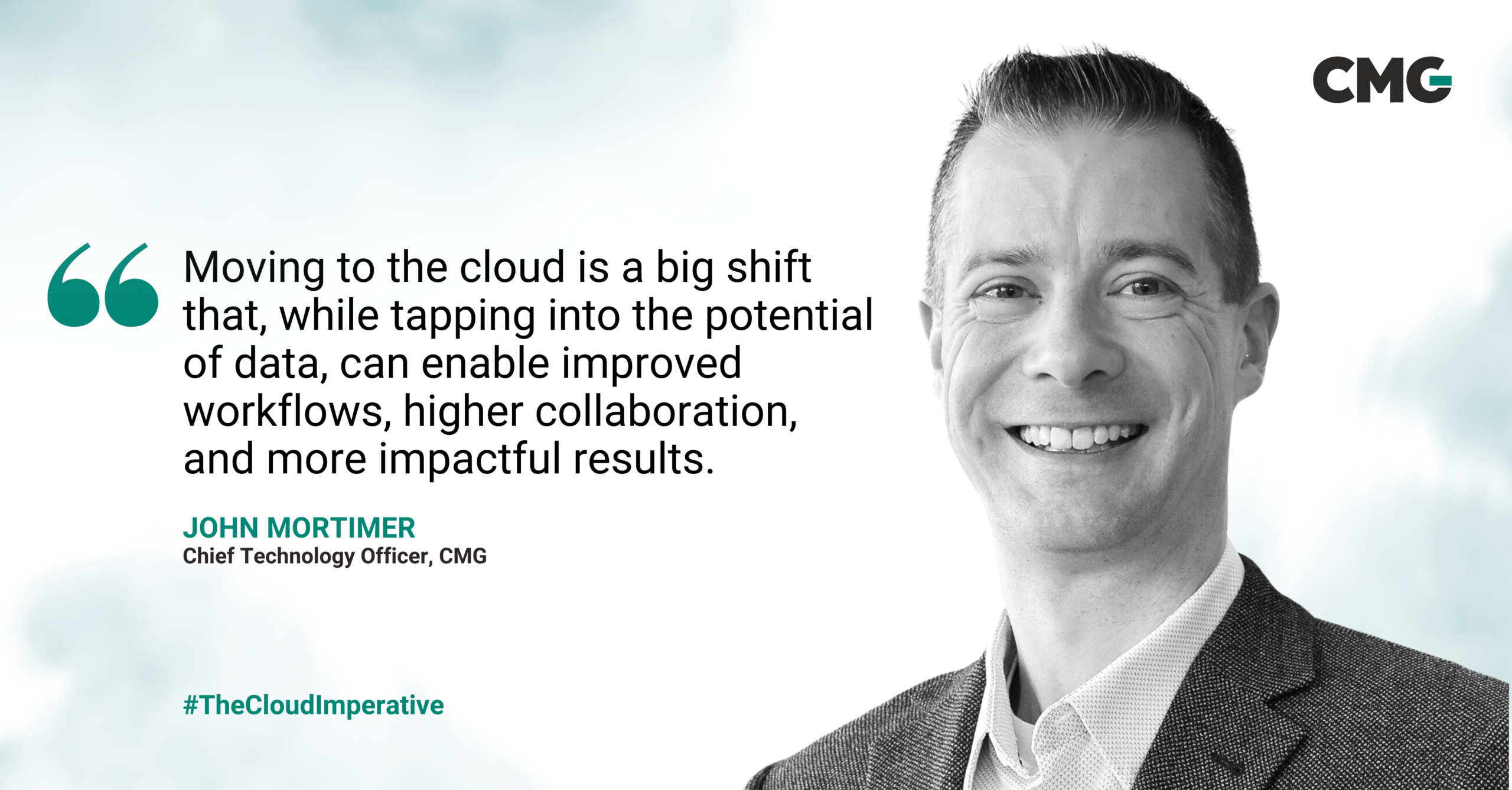
“Moving to the cloud is a big shift that, while tapping into the potential of data, can enable improved workflows, higher collaboration, and more impactful results,” he says.
New technologies are also being applied to the cloud which helps to increase efficiencies, Mortimer says. Examples include artificial intelligence (AI) and machine learning, which can be leveraged to model and process data.
“This provides scale and depth that has never before been possible,” he says.
Mortimer believes the time is now for energy companies to take advantage of efficiencies the cloud can offer to position their companies for the future — particularly as they move to decarbonize their operations.
“We’re at that pivot point today where we’re seeing cloud applications unlock some of the ability to collaborate through applications and workflows, or through access to data that traditionally people wouldn’t be able to have access to,” he adds.
Being in the cloud offers a number of advantages beyond on-prem technology at a scale that isn’t possible without it:
Being in the cloud offers a secure way to scale operations
Mortimer says that questions about data security are a reason that some organizations have held back from making the switch to cloud, but he highlights that those concerns are usually just an unfamiliarity with the infrastructure and not actually a reason not to make the jump.
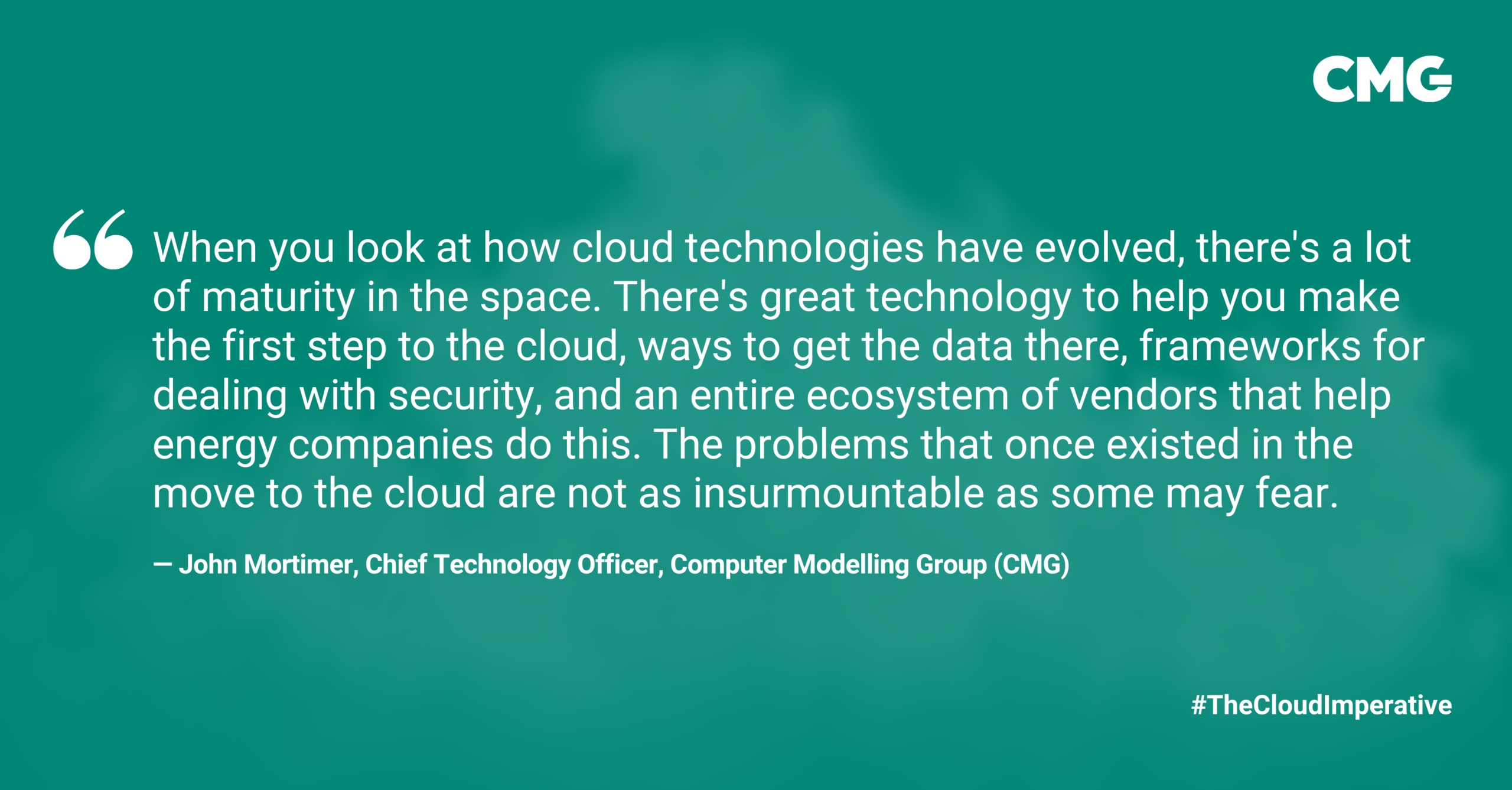
“When you look at how cloud technologies have evolved, there’s a lot of maturity in the space,” he says. “There’s great technology to help you make the first step to the cloud, ways to get the data there, frameworks for dealing with security, and an entire ecosystem of vendors that help energy companies do this. The problems that once existed in the move to the cloud are not as insurmountable as some may fear.”
Traditionally, applications and data have been on-prem, but companies are now seeing an opportunity to unlock the potential of cloud applications in the energy space and are deploying business models and approaches with new workflows that use cloud services.
“There’s a growing recognition that moving to the cloud can still deliver secure environments that protect data and IP, but further value can be created for companies that move to the cloud,” Mortimer says. “Cloud applications and infrastructure can address key security, data privacy, and operating concerns.”
Being in the cloud will attract new talent
The efficiencies and advances created by the cloud will also help attract and retain the future workforce, particularly younger generations looking for careers where they can use and advance their more innate technological skills.
The opportunity to use and work with data is climbing in priority, as pressure is increasing to find more skilled workers in the energy industry, notes Paul Zeppenfeldt of Shell.
“The younger generation coming into the industry today are keen to be exposed to all the data and solve that subsurface puzzle,” says Zeppenfeldt, whose company began its cloud transformation about six years ago.
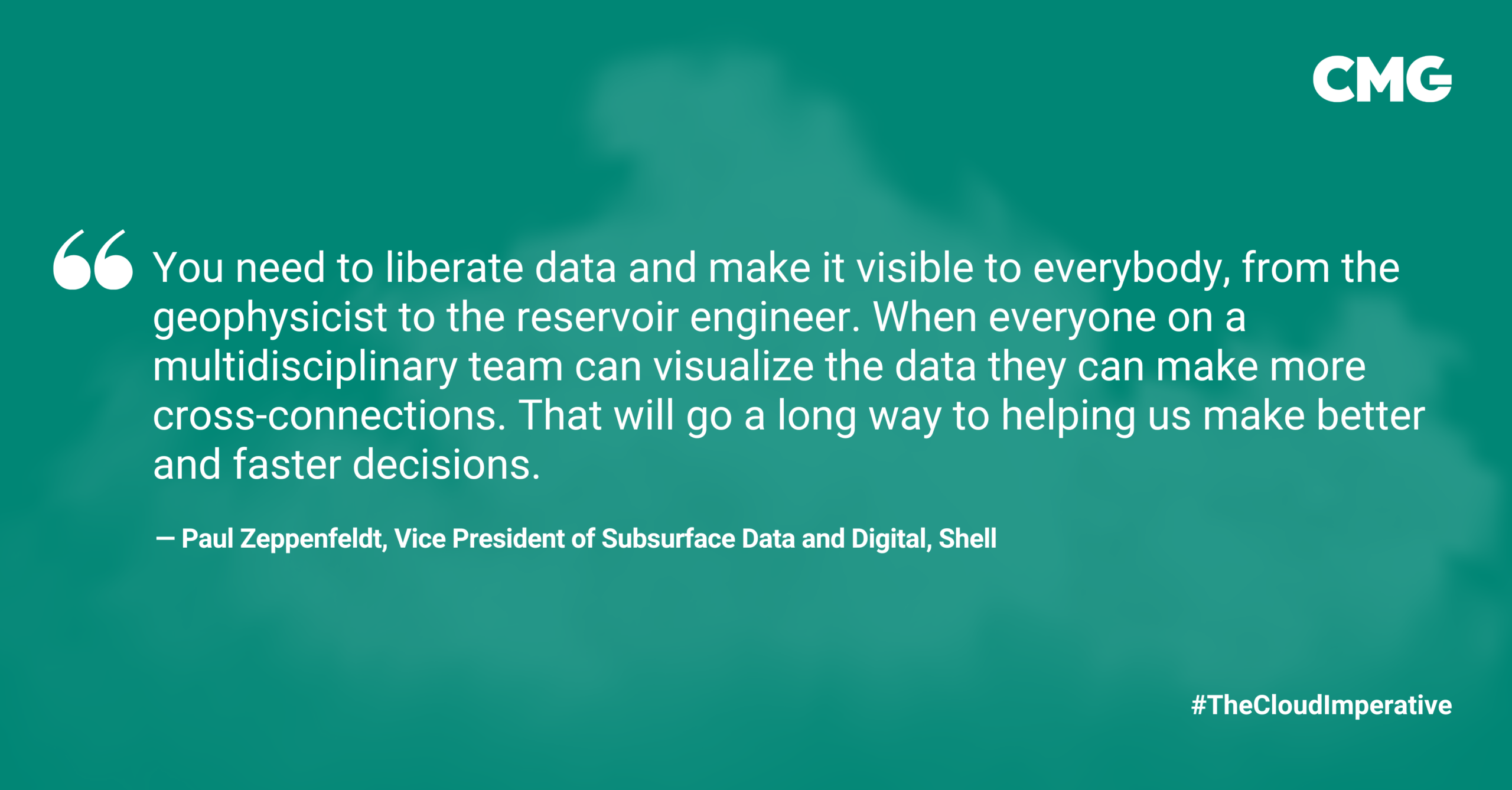
Being in the cloud changes who can participate in teams
“You need to liberate data and make it visible to everybody, from the geophysicist to the reservoir engineer,” Zeppenfeldt says. “When everyone on a multidisciplinary team can visualize the data they can make more cross-connections. That will go a long way to helping us make better and faster decisions.”
The cloud is also allowing energy leaders to connect with a more diverse ecosystem of partners, adds Hussein Shel of AWS. He notes many of these are partners many energy companies have never had access to or didn’t even know existed.
“Energy companies are now engaging in new types of strategic partnerships,” Shel says. “For instance, operators are partnering with cloud providers, as well as service and solution providers. It’s a trifecta of companies who are dramatically changing the design of cloud solutions.”
Collaboration drives innovation and helps energy companies build new capabilities, he adds.
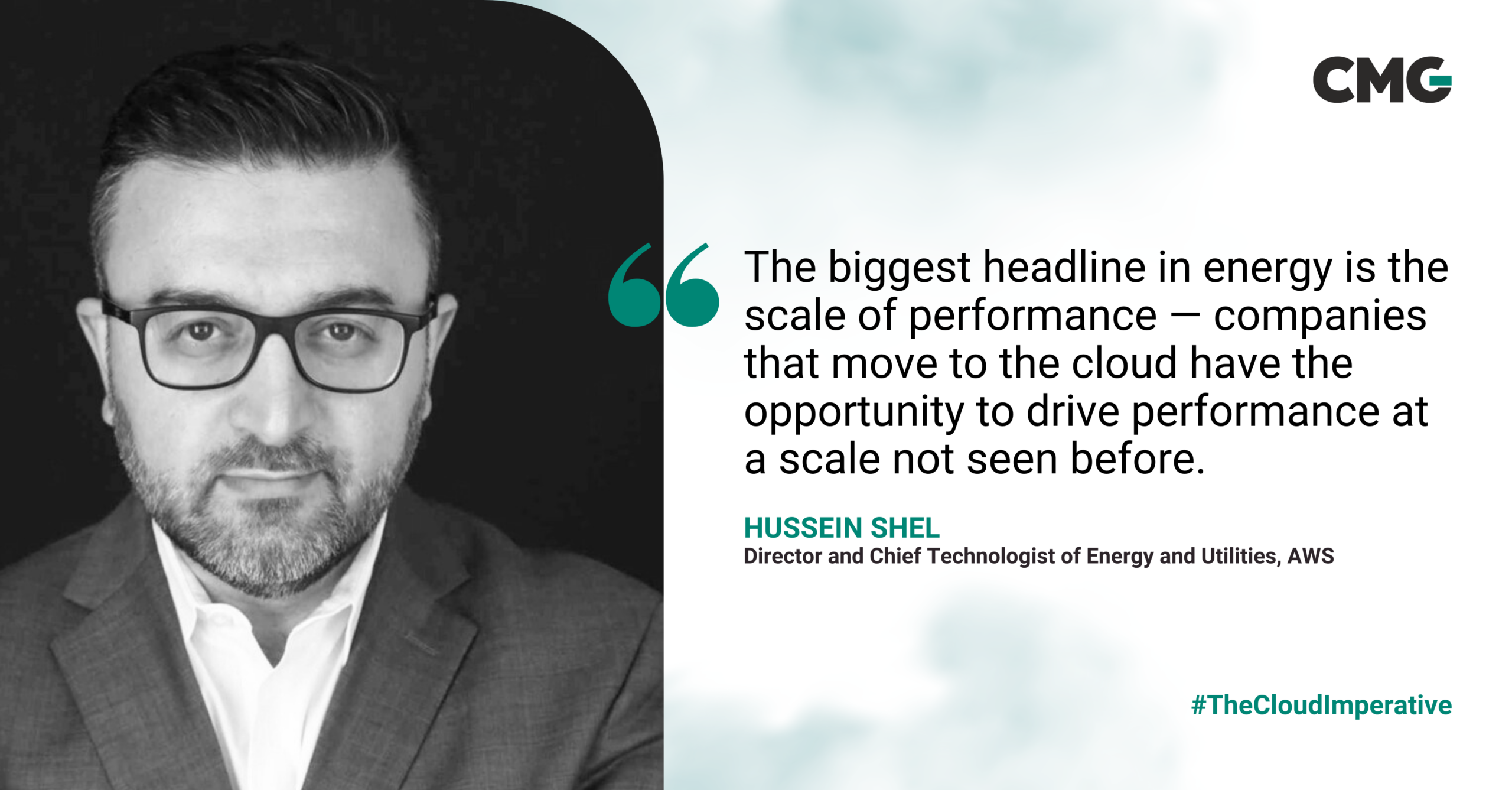
“The biggest headline in energy is the scale of performance — companies that move to the cloud have the opportunity to drive performance at a scale not seen before,” Shel underscores.
Why the energy industry’s journey to the cloud has been different from other industries‘
Moving to the cloud is a huge feat, particularly in the complex and infrastructure-heavy energy industry. It’s why many oil and gas companies have had a longer way to go than some other industries such as retail or technology to make the move.
Data has to be cleaned up, standardized, and then transferred to the cloud where it can be accessed by more people and used in different ways. Subsurface simulation data, for example, can be maps and analysis done on huge aquifers or wells, and it has to be moved from a server in a particular location up to the cloud, which takes time.
“There are more complexities in the energy industry,” says Shel of AWS. “There’s also greater rigor in areas like regulation, geological considerations, and health and safety.”
When Shell began its transition to the cloud in 2017 and into 2018, Zeppenfeldt says the company identified four priority areas in subsurface and wells. By moving data and workflows to the cloud, the company found it was then able to:
- Make better and faster capital decisions.
- Optimize existing assets.
- Increase recovery of fields.
- Enable its workforce to be more productive and efficient.
Zeppenfeldt says this “digital roadmap” was about sharing technical data across subsurface disciplines and thus empowering them.
“You make people more effective if they can not only find all the data they need, but they also understand the context of that data,” he says. “They need to understand what we call the ‘data lineage’.”
Zeppenfeldt underscores that an important part of this process was understanding the data quality, what it can be used for, and who has reviewed it which enables efficiency and better decision making.
Once that data is in the cloud, he says speed and opportunities to scale are unlocked.
For example, Zeppenfeldt says being in the cloud allows Shell to turn on extra processing capability in “bursts of compute” to look for insights. In a project in the Gulf of Mexico, the ability to add computing power “on the fly” cut the time to deliver a seismic velocity model in half.
Hussein Shel of AWS has seen this play out at multiple energy companies, saying that when data is moved off premise and into the cloud, more people can work simultaneously.
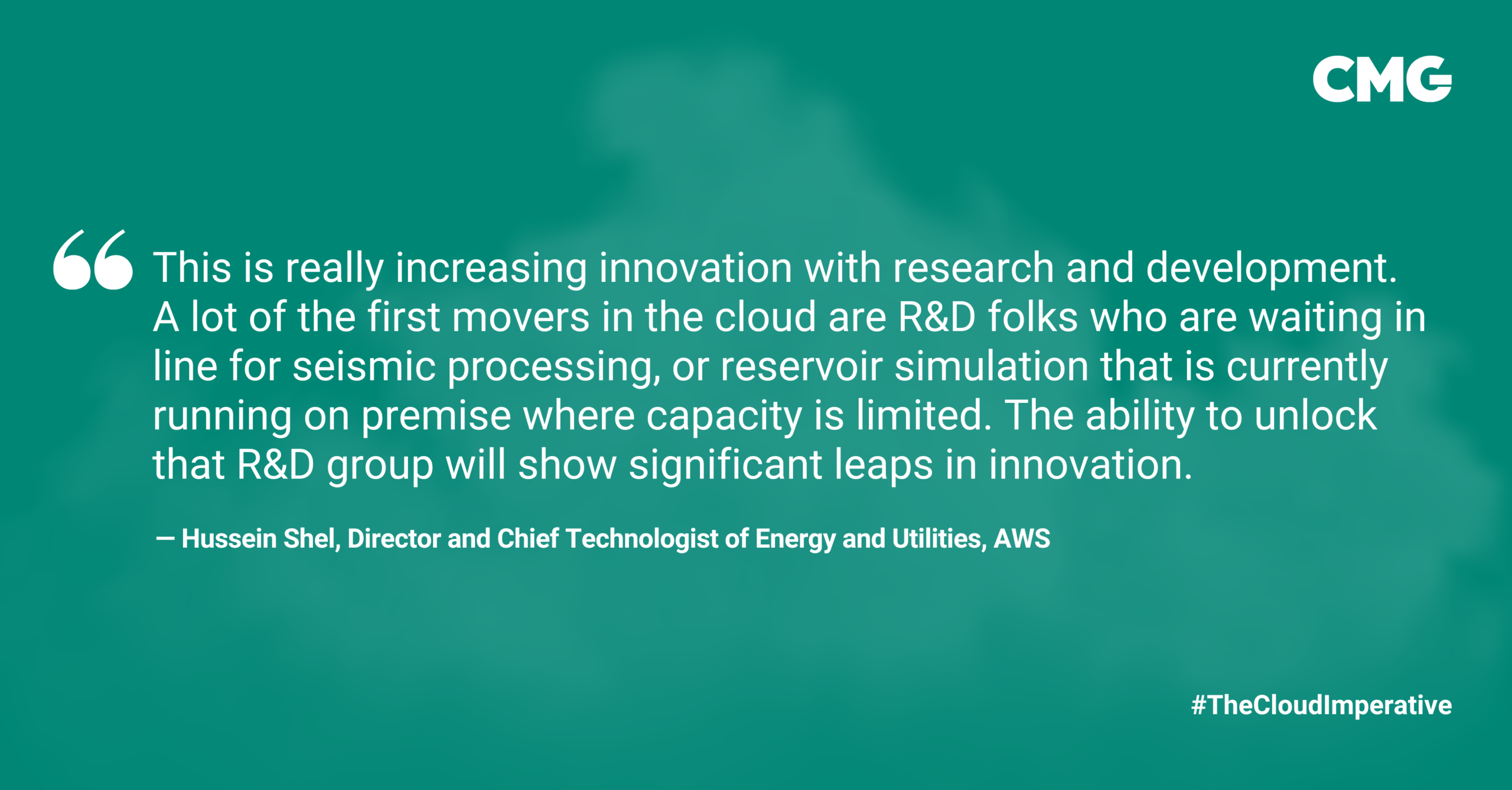
“This is really increasing innovation with research and development,” he says. “A lot of the first movers in the cloud are R&D folks who are waiting in line for seismic processing, or reservoir simulation that is currently running on premise where capacity is limited. The ability to unlock that R&D group will show significant leaps in innovation.”
AI and machine learning can also be added in the cloud. These technologies are being used to perform mundane and repetitive tasks that humans currently need to perform, allowing teams to focus on higher-value priorities.
Cloud collaboration brings ‘enormous’ potential
Energy companies can also create cloud partnerships along with third-party solution providers to improve results. For example, an oil and gas company could upload data for a CCS project to the cloud, and then an authorized partner could access that data for simulation.
“The collaboration potential is enormous,” Mortimer says.
Mortimer says the benefit of having third-party solution providers like CMG is that they can tap into the cloud ecosystem and build more services. He notes that this type of global infrastructure and ability to scale isn’t possible with on-premise systems.
“Scale of this magnitude is achievable for the first time because of cloud and technology,” Mortimer says.
There are also graphics processing units (GPUs) made by companies like Nvidia Corp. and AMD that allow for visualization. These GPUs are available in the cloud, which can help connect the dots with on-premise GPUs.
“These provide high availability, unlimited scale, reliability and more,” adds Shel of AWS. “We partner with others to provide the latest and greatest technology as soon as it’s available, in multiple regions. It removes the administrative burden from companies and operators so they can focus on their main business drivers and not traditional IT infrastructure.”
He points out that data is unlocked as soon as it’s unsiloed, and the opportunity to build and innovate changes as a result.
“It takes you out of that mentality of a black box,” he says. “Transparency is more and more prevalent.”
With more transparency and access to data, Shel says crowdsourcing is emerging in the energy industry, and the results of those efforts have significant potential.
“We’re starting to see crowdsourcing of solutions and answers to some of the industry’s biggest problems emerge,” he says. “Software providers have been using crowdsourcing and open source for decades, and look at the innovation that has occurred as a result.”
CCS, one of the world’s biggest challenges to solve, is a prime example of where cloud and collaboration can benefit.
“To tackle CCS, we need collaboration that has never been seen before, and a lot of simulation and technology,” Mortimer says. “Major investment is going into CCS. We can leverage these advanced capabilities to help solve the storage problem, and that the carbon will remain where we say it will.”
Hussein Shel of AWS points out that the move to standardization of some of the approach is going to be needed, but that isn’t always fast or easy.
“A lot of the equipment, and a lot of the assets that are in place are aging and it can be difficult to provide the consistent datasets for tracking and monitoring,” he says. “It’s important to agree on standards.”
One of the leading cloud collaborations that seeks to do that is the Open Group OSDU Forum, an initiative that seeks to provide a standardized data platform for the energy industry. Its goal is to enable oil and gas companies to collaborate on technology development to help meet the world’s evolving energy needs. The forum’s 240 international members have vowed to work openly and transparently and treat each other equally, regardless of size or type of company.
“It’s unprecedented,” CMG’s Mortimer says of the OSDU Forum. “While companies might compete with each other on having a piece of data or software, what nobody is competing on is what it looks like to share the data across applications, or what the standards are. There are obvious cost savings that will benefit the industry as a whole, while enabling innovation to solve even bigger problems.”
For Mortimer, this is the future of cloud collaboration and advancement in energy and across other industries.
How to conquer the next cloud frontier
The greater the adoption of cloud, the more power and potential the energy industry has to tap into the newest technologies to run complex and large-scale operations, including AI, neural networks and machine learning.
And there are wide-sweeping benefits.
For example, predictive maintenance and applications can be built using AI, saving companies billions of dollars. The technology could also connect the surface and subsurface, modelling and de-risking energy projects.
AI will be particularly critical for the industry as it develops and scales CCS and other decarbonization projects. These technologies have the potential to change decision-making around the economics of energy projects in the future.
“As a technologist, I’m extremely excited about the work we can do with these types of technologies,” Zeppenfeldt of Shell says.
Hussein Shel of AWS is also excited about shaping the future of how data is used and collected in the industry.
“You need solid cloud partners who know how to scale with high-performance computing,” he says. “And while the partnership piece is important, the execution of that partnership is critical.”
For Shel, connecting surface and subsurface teams via the cloud is going to yield significant potential.
“Bringing these worlds closer is important. Look at the surface, look at capacity, look at pipelines, look at compressors, and look at all of the assets that you don’t think about. Use machine learning, and simulation to create what-if scenarios. It’s key to driving decisions, and in many cases, these are billion-dollar decisions that can be made with the help of applications.”
To truly take advantage of cloud capabilities, Zeppenfeldt said it’s important that businesses not only invest in the systems and processes but also the people who will be working with them.
“Don’t underestimate how much of a shift it is in how people work,” he says. “Moving to the cloud requires change in applications, but it also requires a change in people, arguably the most important part of the transition.”
The roundtable discussion wraps up where it started — with a recognition that teamwork and collaboration play a critical role in the success of cloud, and scaling opportunities.
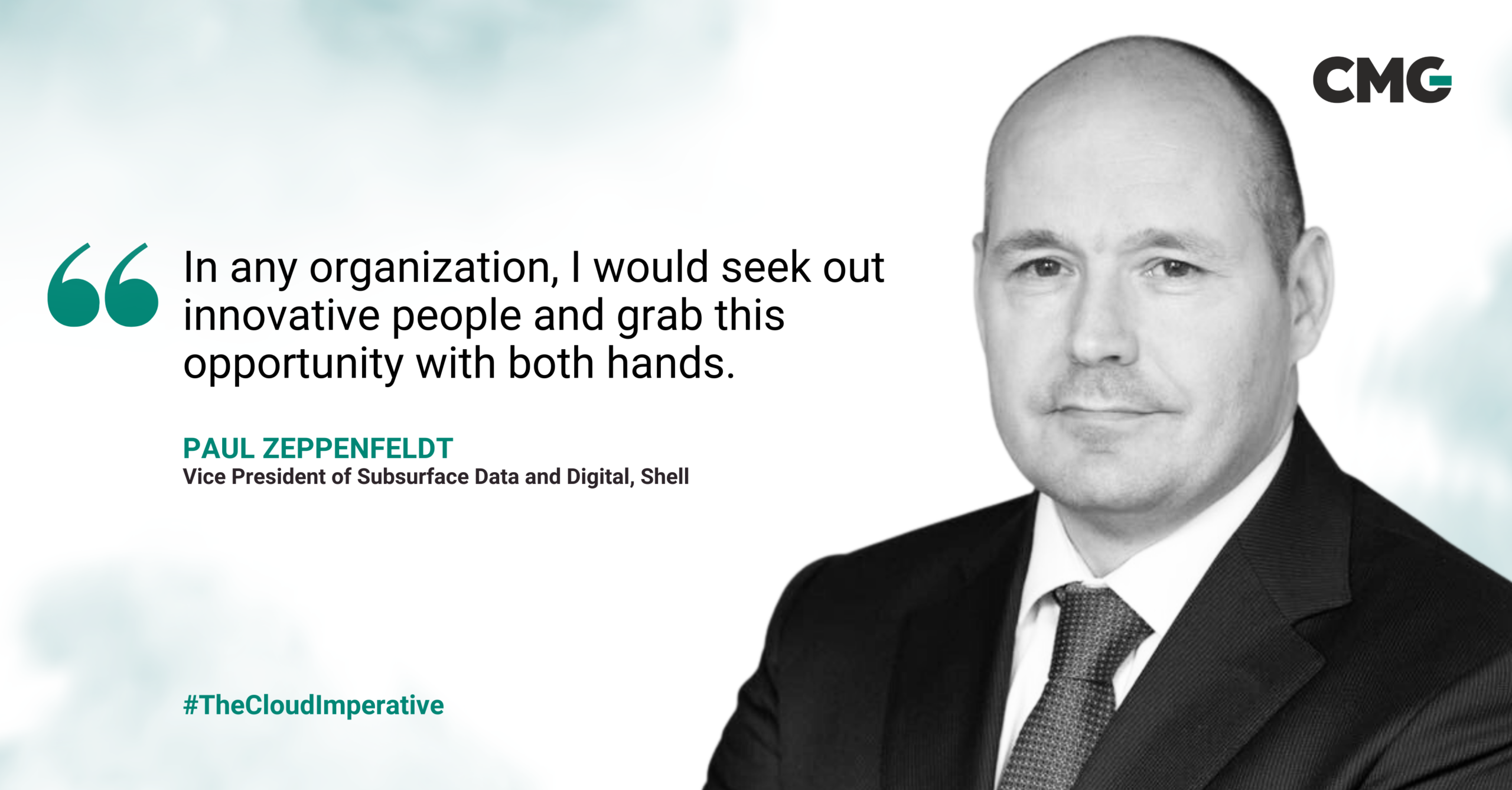
“In any organization, I would seek out innovative people and grab this opportunity with both hands,” Zeppenfeldt says.
Mortimer of CMG agrees, adding that an entire ecosystem of partners is waiting to help companies when they’re ready to move to cloud systems.
“Problems are not as insurmountable as people think — especially if you leverage the experience out there, and companies who want to grow with you,” he says.
For Shel of AWS, three-way partnerships — including cloud provider, operator, and solution provider — will also open up new opportunities for providers and partners.
“Because data has been liberated, and it includes information that some have never thought about, there are new opportunities for providers and partners to innovate and create new revenue sources.”







